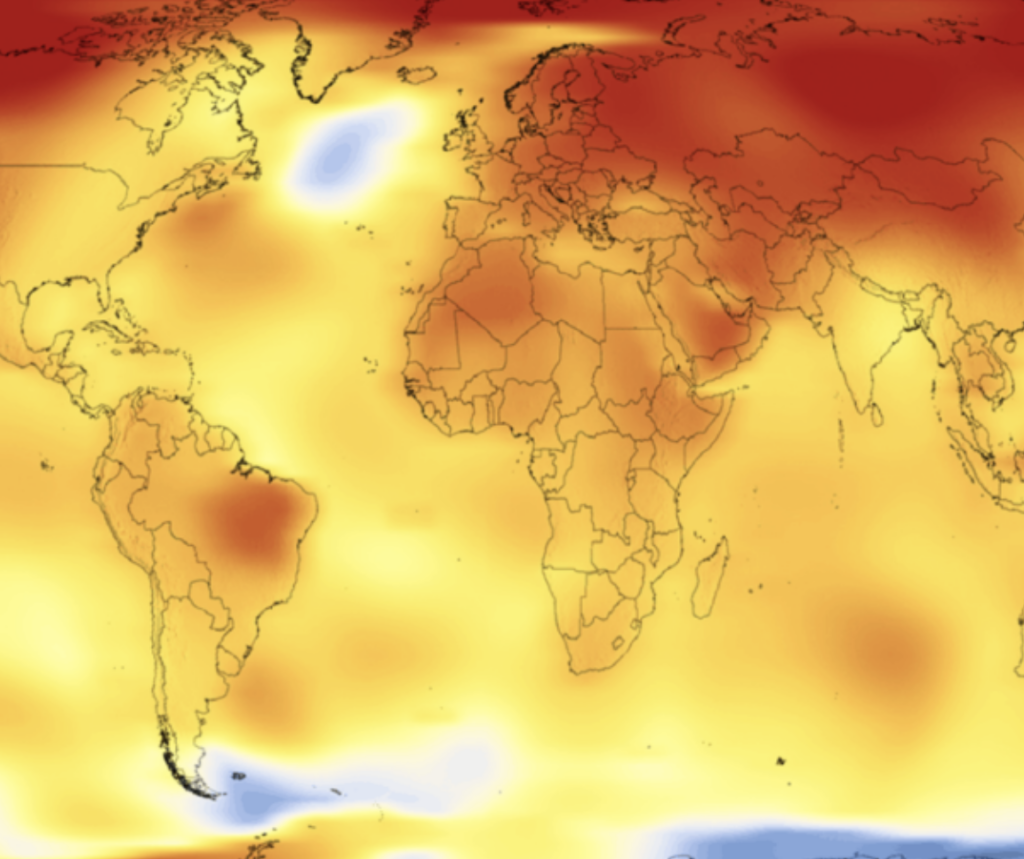2023 was the hottest year on record, where the average global temperature was 14.98 degrees Celsius, 0.17 degrees above the previous record set in 2016. This works out at 1.48c above pre-industrial levels.
This is dangerously close to the 1.5c limit set as part of the Paris Agreement in 2015, where over 200 countries, including the UK, agreed to see as an absolute limit. This 1.48c is the average for the entire year of 2023.

However, there were times when it was substantially higher than this. On 17th November last year, the global average temperature was 2.06c higher than pre-industrialised levels for the first time since records began. This was preliminary data reported from the European Center for Medium-Range Weather Forecasts. While this was a ‘blip’, around 33% of days in 2023 saw the average global temperature being at least 1.5C higher than pre-industrial levels – and that figure was quoted back in October. Now that 2023 has ended, the final calculations for the year have been worked out, giving this alarming 1.48c yearly average increase.
El Niño
While the heat in 2023 was mainly caused by climate change, El Niño, which is a natural climate variability which increases heat in the Pacific Ocean, also exacerbated this. However, climate scientists are more concerned about the long-term state of global warming rather than individual years. The pattern of continued heat records over many years will ultimately cause chaos to the planet.

Implications of Climate Change
It’s easy to bounce statistics around, quoting figures, which for many people may just look like rather tiny temperate increases, which may not spark much fear. But the planet’s ecosystem is incredibly fragile, and slight changes (such as 2c) can will have a dramatic impact on the world we live in. Here are a few implications that a 2c increase in global temperatures will bring:
Extreme Heat – 37% of the world’s population will experience extreme heat at least once every five years. At 1.5c it’s just 14%.
Sea-Ice-Free Arctic – It’s estimated the number of ice-free summers in the Arctic will be once every ten years at a 2c increase. This figure is expected to be once every 100 years at a 1.5c increase.
Rising Sea Levels – By the year 2100, with a 2c increase, sea levels are set to rise by 0.46 metres. At 1.5c they will be closer to 0.4 metes.
Fisheries – At a 2c increase, it’s expected that there will be a 3 million tonne reduction in fish available for food. This reduces to 1.5 million tonnes lost if temperature increases are kept to 1.5c.
Crop Yields in Tropics – There will be a 7% reduction in maize harvests in the tropics with a 2c increase. At a 1.5c increase, this decline will be around 3%.
What Can You Do?
There are a number of things you can do to lower your carbon footprint. As an individual, the changes may seem tiny and insignificant, but if everyone makes changes – together, we can make a big difference. There are simple changes, including:
How you can reduce your carbon footprint:
1. Energy Saving Bulbs. Save around £35-£40 a year with LED/Energy Saving Bulbs. Although they cost more to buy, they use less energy and last a great deal longer than regular bulbs.
2. Lower Your Thermostat Temperature. You can save between 2-4% on your heating for each degree you drop on your thermostat and thus lower your carbon footprint. An easy way to save here is to drop the temperature 1 degree at a time and keep doing this over several days until you arrive at a temperature that you find comfortable. It could easily save 10% or more off your heating costs.
3. Select Energy-Saving Appliances – Take the time to look for energy-saving appliances when the time comes to renew. Efficiency labels score appliances from A+++ to G, the former being the most efficient. The more efficient an appliance, the cleaner it will be for the environment.
4. Wood Burning Stoves – If you have been reading our various posts and articles about stove efficiency, you will already be an expert in how to ensure the maximum efficiency of your stove.
5. Reduce Your Water Temperature – Many households have their water far too hot, which is a waste. A quick and easy tip here is to reduce the water temperature in small intervals until you reach a level you are happy with (i.e the lowest temperature, which is still comfortable to use).
Can burning wood help lower global emissions?
Despite misleading information in some media outlets, burning firewood, if done so correctly, is highly environmentally friendly and sustainable as long as:

1. You’re sourcing wood from sustainable woodlands
2. You’re burning seasoned wood
3. You’re burning this seasoned wood on an Ecodesign stove
Woodlands MUST be sustainable. Here are a few key facts about woodlands and forests:
1. Forests cover around 30% of the world’s land area
2. Forests contain most of the world’s biodiversity and almost as much carbon as in the atmosphere
3. Directly and indirectly, forests and woodlands provide livelihoods for over one billion people
4. Forests influence the availability of water, regulate surface and groundwater flows, and also help maintain high water quality
5. Forests and trees reduce water-related risks such as landslides, floods and droughts.








